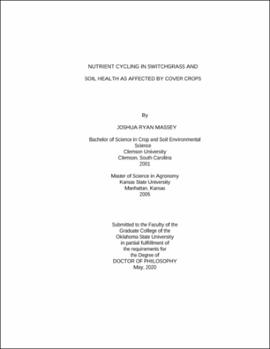| dc.contributor.advisor | Zhang, Hailin | |
| dc.contributor.author | Massey, Joshua Ryan | |
| dc.date.accessioned | 2020-09-09T20:49:15Z | |
| dc.date.available | 2020-09-09T20:49:15Z | |
| dc.date.issued | 2020-05 | |
| dc.identifier.uri | https://hdl.handle.net/11244/325445 | |
| dc.description.abstract | The focus of these studies was nutrient management of specialty crops. Management practices for switchgrass fertilization in production of biofuel feedstock and forage hay are variable depending on climate, harvest timing and cultivar. Switchgrass studies focused on aspects of fertilization, nutrient cycling and harvest timing. Positive trends in yield with increasing rates of nitrogen (N) fertilizer (P < 0.05) were observed in some years while no yield differences were found due to P fertilization. Nitrogen use efficiency increased with N rate (P < 0.05). Nutrient translocation is a likely contributor to low fertilizer response. Aboveground (AG) biomass (leaves and stems) and belowground (BG) (roots) were analyzed for yield (AG) and nutrient concentrations (AG and BG). Maximum aboveground biomass ranged from 13.7±2.9 to 19.8±1.2 Mg ha-1 across years until senescence. Nitrogen concentration of AG decreased as season progressed (P < 0.0001). Belowground N increased over time from 3.3 to 13.9 g N kg-1 in two of three study years (P < 0.05), indicating macronutrients movement from AG to BG. Nutrients stored in roots can be used for regrowth in the following growing season. When assessing biomass quality by harvest timing, tissue-N removal increased from the 0 to the 235 kg N ha-1 application rate (P < 0.05). Nitrogen removal decreased during subsequent harvests at a fixed N rate (P ≤ 0.0001). Quality was most impacted by harvesting time. Fibers and most minerals in the biomass increased as accumulated growing degree days (AGDD) increased (P ≤ 0.0001), but N and total digestible nutrients (TDN) decreased as AGDD increased (P ≤ 0.0001). Vegetable growers face challenges of soil quality degradation with conventional tillage. Cover crops add soil organic matter (SOM) to improve soil health parameters and vegetable crop production. Four cover crop treatments were studied, including clean fallow as a control. Gravitational water content, water stable aggregates, and microbial CO2-C were significantly lower in fallow compared to some cover treatments. Few significant differences in cash crop yields with cover crop combinations were seen in this study. Perhaps treatments had not been in place long enough to significantly improve soil health parameters like SOM. | |
| dc.format | application/pdf | |
| dc.language | en_US | |
| dc.rights | Copyright is held by the author who has granted the Oklahoma State University Library the non-exclusive right to share this material in its institutional repository. Contact Digital Library Services at lib-dls@okstate.edu or 405-744-9161 for the permission policy on the use, reproduction or distribution of this material. | |
| dc.title | Nutrient cycling in switchgrass and soil health as affected by cover crops | |
| dc.contributor.committeeMember | Warren, Jason | |
| dc.contributor.committeeMember | Wu, Yanqi | |
| dc.contributor.committeeMember | Brandenberger, Lynn | |
| osu.filename | Massey_okstate_0664D_16660.pdf | |
| osu.accesstype | Open Access | |
| dc.type.genre | Dissertation | |
| dc.type.material | Text | |
| dc.subject.keywords | biomass quality | |
| dc.subject.keywords | cover crops | |
| dc.subject.keywords | nutrient cycling | |
| dc.subject.keywords | soil health | |
| dc.subject.keywords | switchgrass | |
| dc.subject.keywords | vegetable crops | |
| thesis.degree.discipline | Soil Science | |
| thesis.degree.grantor | Oklahoma State University | |
